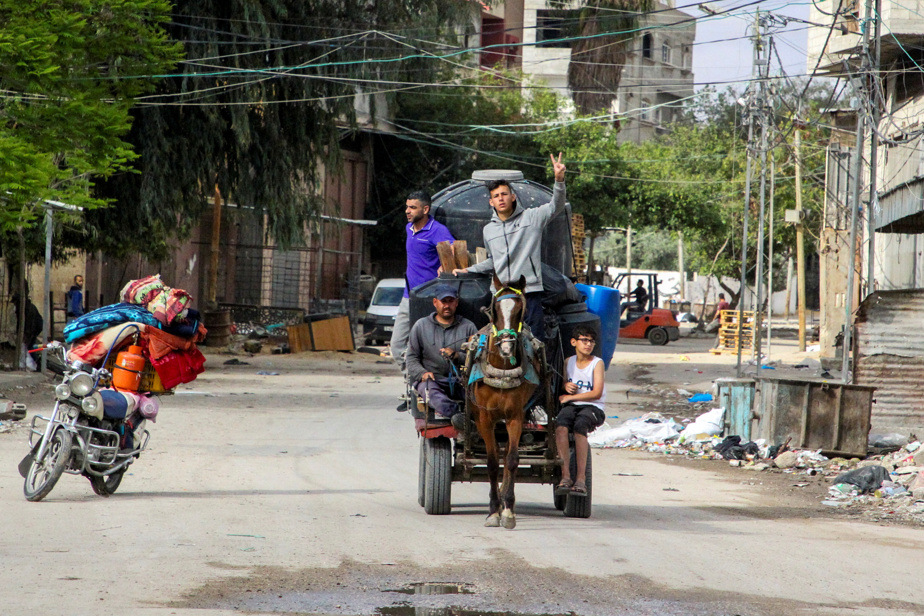(Rafah) Deadly Israeli strikes and ground operations show no respite in the besieged and famine-threatened Gaza Strip, more than seven months after the start of the war which has claimed the lives of more than 35,000 Palestinians according to Hamas on Sunday.
The Israeli army’s major offensive, triggered by an unprecedented bloody attack by the Palestinian Islamist movement Hamas against Israel on October 7, has devastated the small, overpopulated Palestinian territory, where according to the UN there is no longer “any safe place” for the approximately 2.4 million residents.
The greatest international fears today concern the town of Rafah, in the south of the Gaza Strip, and the approximately 1.4 million Palestinians crowded there, the majority displaced by destructive bombings and fighting.
Israel, which has sworn to annihilate Hamas, wants to launch a ground offensive in Rafah, which it considers to be the movement’s last bastion in the Palestinian territory besieged by its army since October 9.
But for US Secretary of State Antony Blinken, whose country opposes a major assault in Rafah, “there will still be thousands of armed Hamas members” even with such an intervention.
On foot, aboard vehicles or tricycles, Palestinians continue to flee areas of Rafah to try to find refuge elsewhere in the Palestinian territory.
“We lived through hell for three days and the worst nights since the start of the war,” Mohammed Hamad, 24, who is one of 300,000 Palestinians who Israel says have fled the areas, told AFP of eastern Rafah targeted by bombings after the army’s evacuation orders.
It claimed that its troops were continuing “targeted” operations against Hamas in eastern Rafah, and “ten terrorists were eliminated there”.
In the past 24 hours, at least 63 Palestinians have died in Israeli bombardments in the Gaza Strip, according to the Gaza Health Ministry. A Rafah hospital said it had received the bodies of 18 people.
“Israeli military vehicles advanced about 2.5 kilometers deep” from Rafah, Gaza crossings authority spokesman Hicham Adwan said.
The armed wing of Hamas claimed responsibility for shelling Israeli soldiers and vehicles near the Rafah crossing.
“Israeli authorities continue to issue forced displacement orders […] This forces residents of Rafah to flee anywhere,” the head of the UN agency for Palestinian refugees (UNRWA) wrote on ), Philippe Lazzarini. “Talk about safe zones is false and misleading. No place is safe in Gaza,” he said.
Volker Türk, UN High Commissioner for Human Rights, also said that “there is no safe place in Gaza.” The towns supposed to receive displaced people are already “reduced to ruins”.
By attacking Rafah, Israeli Prime Minister Benjamin Netanyahu wanted to “derail” talks on a truce and the release of hostages held in Gaza, Hamas accused on Sunday.
The latter claimed to have accepted a proposal from the mediators – Egypt, Qatar, United States – on a truce, but Israel responded that the accepted proposal was “far from [its] demands”.
Egypt said it wanted to join South Africa in its request to the International Court of Justice to impose new emergency measures on Israel, after “the extent of Israeli attacks against Palestinian civilians”. .
In northern Gaza, the army launched operations in Jabaliya after issuing evacuation orders from this sector where, according to it, “Hamas is trying to rebuild its military capabilities.”
Considered a terrorist group by Israel, the European Union and the United States, Hamas took power in Gaza, a narrow strip of land neighboring southern Israel, in 2007.
On October 7, Hamas commandos infiltrated from Gaza in southern Israel launched an attack which left more than 1,170 dead, mostly civilians, according to an AFP report based on official data. More than 250 people were kidnapped during the attack and 128 remain captive in Gaza, of whom 36 are believed to have died, according to the army.
In response, the army launched intense bombings followed by a ground offensive on October 27, which ravaged Gaza, displaced the majority of the population and caused a humanitarian catastrophe with an imminent threat of famine according to the UN and a heavy human toll: 35,034 deaths, the majority civilians according to the Hamas Ministry of Health.
The army has deplored the loss of 272 of its soldiers in the military campaign in Gaza since October 27.
UN chief Antonio Guterres again called for a ceasefire and the release of hostages, at a conference in Kuwait where donors pledged more than $2 billion over two years for humanitarian operations in Gaza.
The entry of aid into Gaza has been virtually blocked, according to the UN, since the army entered eastern Rafah on Monday and seized the border crossing with Egypt, blocking a key entry point for convoys. aids.
The army announced the opening of a new access, “the ‘Erez-West’ crossing”, in northern Gaza to allow the entry of aid. Around thirty trucks loaded with aid from the north of the territory then entered Gaza City, AFP noted.


















